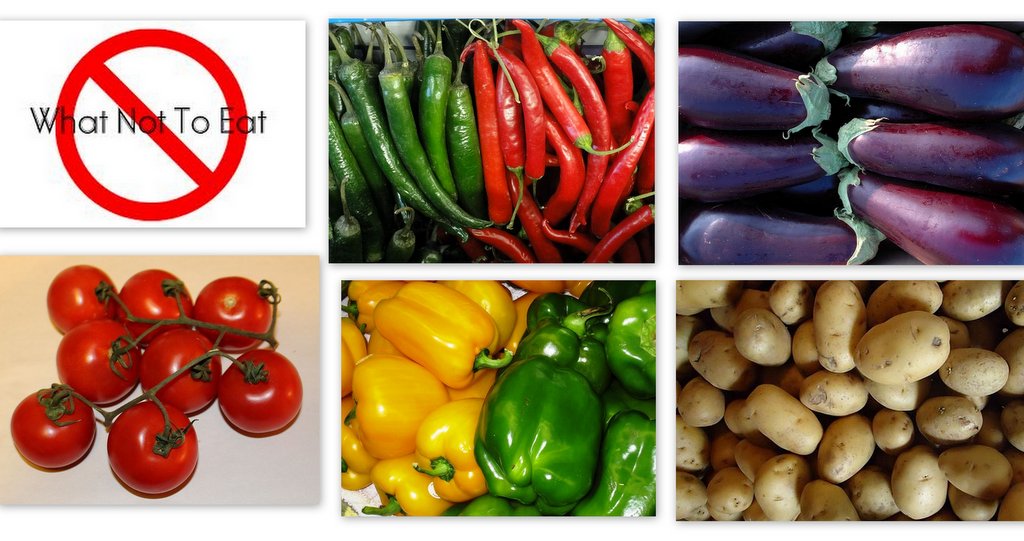Nightshades and Solanine Toxicity Syndrome
 What do tomatoes, potatoes (not sweet potato), eggplant, paprika, goji berries, peppers (not your common black and white peppercorns), tobacco, and tomatillos all have in common? Most people would consider them all as healthy foods, which should be eaten daily, correct? But what if I told you they all contained a dangerous neuro-toxin called alpha-solanine.
What do tomatoes, potatoes (not sweet potato), eggplant, paprika, goji berries, peppers (not your common black and white peppercorns), tobacco, and tomatillos all have in common? Most people would consider them all as healthy foods, which should be eaten daily, correct? But what if I told you they all contained a dangerous neuro-toxin called alpha-solanine.
All of the vegetables mentioned are part of the Solanaceae family, aka Nightshades. The  nightshade family consists of over 2,000 plants, including Belladonna, which was used throughout history as a key part of potions and lotions used by witches in times past. “Witches Flying Potion” contained nightshades and was used as a strong hallucinogen. Except for in South America, most nightshades were looked at as being poison until the 1800’s.
nightshade family consists of over 2,000 plants, including Belladonna, which was used throughout history as a key part of potions and lotions used by witches in times past. “Witches Flying Potion” contained nightshades and was used as a strong hallucinogen. Except for in South America, most nightshades were looked at as being poison until the 1800’s.
But aren’t tomatoes, eggplant, peppers, etc. healthy???
All members of nightshade plants contain a toxic alkaloid called alpha-solanine. The content is higher in the leaves and stems, which is why it can be deadly to consume tomato or potato leaves. Tomatoes and potatoes contain higher levels of solanine while green, although even the ripest ones still contain small amounts of the deadly toxin. In 1979 in a school south of London 78 schoolboys fell sick with diarrhea, vomiting, and central nervous system depression. Some hallucinated for days. After an investigation they were able to pinpoint the cause, the boys had eaten boiled green potatoes at school.
While most people don’t have as extreme of symptoms from eating a ripe tomato or potato (or any nightshade), they can wreak havoc on your body. Applied Kinesiologist Dr. Michael Lebowitz named this chronic exposure “Solanine Toxicity Syndrome”.
Alpha Solanine 
Alpha Solanine is a glycol-alkaloid poison, which is found in all members of the nightshade family. It serves the plant by acting as a natural pesticide. While it is found in minute amounts in vegetables such as potatoes, tomatoes, etc. as little as the consumption of 50-200mg in the average size person can cause death. Solanine is an acetlycholinesterase inhibitor, which can alter mitochondria function and increase calcium levels in the cytoplasm. Calcium is also leached from bones (leading to osteoporosis) and can be deposited elsewhere (leading to atherosclerosis). Solanine can be stored in all organs of the body, especially the thyroid gland. In some people this is a common cause of hypothyroid issues.
Many of the issues with solanine are because it cannot be broken down by the body, and is excreted in a very slow manner. In the book “Nightshade Free, Pain Free” by Michael Fowler he states the average person consumes 13 mg of solanine per day with a half-life (the time it takes your body to excrete the first 50%) of 1-2 months. Compare that to caffeine, which has an average half-life of less than 6 hours.
Common issues caused by nightshade consumption:
Autoimmune Disorders and Nightshades (Rheumatoid Arthritis, Psoriatic Arthritis, Lupus, etc.):
Dr. Norman Childers, a botanist at the University of Florida, did a questionnaire study on people suffering from arthritis over a 20-year period and found that nightshades were a contributing factor to arthritis sufferers. In patient responses he found over 70% of all patients showed improvement by following a nightshade free diet. Dr. Childers had readers of his books complete a similar questionnaire of which a staggering 94% of participants reported substantial or complete relief from following a strict nightshade free diet.
Osteoporosis and Nightshades:
As mentioned before, Dr. Norman Childers has been researching nightshades for 50+ years and teaches that calcium is removed from ones bones and also mitochondria (decreasing ones energy) when one overeats nightshades. This leaching of calcium from the bones can predispose someone to osteoporosis. He saw that in patients with osteoporosis he was never able to reverse it with calcium or vitamin D supplementation until he also removed nightshades from their diet.
Atherosclerosis and Nightshades:
With the calcium removal caused by nightshade consumption from ones bones and other cells, where does it go? This calcium has to go somewhere, and can be deposited in ones arteries, contributing to atherosclerosis and heart disease.
Arthritis and Nightshades:
Calcium deposition can also occur in joints of the body, which will cause irritation and inflammation. This irritation can increase the progression of “wear and tear” arthritis in people.
Some doctors also hypothesize (supported by initial testing) that most athletes who need to undergo Tommy John Surgery have a nightshade issue. The nightshade consumption can cause calcium deposition around the elbow (among other places), increasing the risk of a rupture of the ulnar collateral ligament.
Digestive issues and Nightshades:
In addition to containing solanine, nightshades also contain lectins. When lectins go through the digestive tract they stick to the sides and can cause and/or exacerbate leaky gut.
“Common” aches and pains and Nightshades:
Solanine and other chemicals in nightshades will alter neuronal transmission to muscles, in addition to increasing inflammation, causing calcium deposition, and causing muscle spasms due to the inhibition of acetylcholinesterase from solanine.
Skeptics?
You can go on various arthritis websites where “researchers” post articles saying that nightshades play no role in arthritis and it’s a load of rubbish. What is interesting is if you read the comments on these articles on the bottom of the page. There are literally hundreds of comments/testimonials from arthritis sufferers saying how their arthritis greatly improved when following a no nightshade diet.
In today’s society, we want to see instant fixes. As mentioned before, the half-life of nightshades is very slow, and it can take weeks to months to fully detox ones nightshade storage. Some patients don’t see initial results as fast as they want and give up on the diet.
In my clinical experience I have seen anything rheumatoid arthritis (RA), osteoarthritis, skin rashes (eczema, psoriasis), Irritable Bowel Syndrome (IBS), and many other conditions all be relieved by removing nightshades from ones diet.
 In school for ranchers to successfully raise livestock they are taught to keep their livestock away from nightshade plants. In addition to death, ranchers have found that nightshade toxicity causes: “central nervous system problems. Symptoms are incoordination, excessive salivation, labored breathing, progressive weakness or paralysis, and nasal discharge. It can also cause gastrointestinal problems like nausea, abdominal pain, vomiting and diarrhea.”
In school for ranchers to successfully raise livestock they are taught to keep their livestock away from nightshade plants. In addition to death, ranchers have found that nightshade toxicity causes: “central nervous system problems. Symptoms are incoordination, excessive salivation, labored breathing, progressive weakness or paralysis, and nasal discharge. It can also cause gastrointestinal problems like nausea, abdominal pain, vomiting and diarrhea.”
While nightshades aren’t necessarily good for anyone, they aren’t pure evil either, they do contain some beneficial nutrients. Many people eat nightshades with no symptoms. Why is this? Some people can excrete it better than others, some are initially healthier and can handle the toxins without any outward symptoms, and other people’s genetics allow them to process solanine better. But if you suffer from any of the symptoms above you might be suffering from Solanine Toxicity Syndrome.
Will avoiding nightshades be a fix-all diet?
Simply put, No. If any doctor tells you that one diet, avoiding one food, or taking one supplement will fix all health issues, I would pack up and leave his office. There is no one fix for all health issues. Other food sensitivities can play a large role in inflammation and illness and could include Gluten, Dairy, Caffeine, Eggs, Corn, etc. Dysbiosis (too many “bad” microbes in one’s gut” and not enough good ones) including bacteria, parasites, and fungus can all increase inflammation and alter one’s biochemistry, causing a multitude of issues. Let’s not forget heavy metal and/or chemical toxicity in the body. More on each of these issues will be talked about in future blog posts on my website.
While avoiding nightshades may help you greatly, I never recommend a “one diet” or one “treatment plan” for everyone. The best way to find out if you have a nightshade sensitivity is to be checked by a Professional Applied Kinesiologist using specialized testing to check if you have this sensitivity. The physician can also check you for the other issues mentioned above including dysbiosis, heavy metal toxicity, etc. to give you the most specific treatment plan in helping to restore you back to your optimal health.
I hope you’ve found this information helpful.
Please share my article with your friends and family and as always feel free to comment below or email me directly at DrNoahLebowitz@gmail.com if you have any questions.
Live Healthy & Be Active
And if this article has really made you hate tomatoes, here is a fun game to get out your frustration!
Dr. Noah

-Dr. Noah Lebowitz is a second generation Chiropractor and Applied Kinesiologist practicing in Pukalani / Makawao Maui HI. Dr. Lebowitz treats the chronically ill patient with fatigue, intestinal issues, depression, autoimmune conditions, etc. The patients he sees have often seen many other doctors beforehand and are able to be helped using the unique protocol developed by Michael Lebowitz DC. He also works with professional athletes (including NHL and MLB All-Stars and MVP players) and amateurs working to optimize muscle function and nutrition helping decrease injuries and increase performance.

why are these called “night shades”
The etymology is not exactly know. Dr. Childers says: “It is thought the name originated among the Romans who ground up a so-called deadly black nightshade and put it in an alcoholic drink intended for an enemy. The shade came down for a long night: they died.”
If you read on wikipedia or other sources there are other various theories also, but as far as I know, no one is exactly sure of where the name comes from.
How about tomatoe paste or pickles the night shade veg … i’d love ketsup. 🙁
Tomato paste is definitely filled with nightshades because of the tomato. Pickles are sometimes OK and sometimes not. If the ingredients says “spices” it often times has peppers or another nightshade in. For the very sensitive person even this tiny amount can be problematic.
Something to consider, many of the nightshade plant family have the uncommon characteristic of flowering during the night, which, during a bright moonlight, gives them a definite highlight in the landscape and easy to identify. So there is this connection to “night” and “lunar” that gives credence to the folklore.
Very interesting. Thanks!
Dairy also contains nightshade toxin. Your article does not mention this.
Thank you for bringing this important topic to discussion.
Dairy does contain components many react to (Casein, Lactose, etc.) but I don’t believe it contains nightshades. If you have a source I’d love to see it!
Thanks 🙂
Does heat/cooking break down the toxins making them safer to eat?
Some studies show cooking to break them down slightly, but I (and many other doctors I know) have never seen it to be enough to make any difference in anyone who is nightshade sensitive. So they have to avoid them in all forms.
I see yellow and green bell peppers are pictured as avoids. Are *red* bell peppers also avoids?
Hi Chris,
Yes, all peppers are (yellow, green, red, jalapeños, habaneros, chili, etc.) nightshades and contain solanine.
Black table pepper is a separate family though and not a nightshade.
Dr. Noah
Pingback: Active with Arthritis - kathgriffin
Why no eggs? I am wondering why they could be a problem.
It all depends on the person but I see a lot of people not due well on eggs due to the Albumin protein. Removing eggs from ones diet can greatly improve health in certain people
Are turnips a good substitute for potatoes in an auto-immune Paleo type diet?
I have Hashimotos and have been on a very strict Paleo diet for 5 months. I’ve lost 35 pounds.
My energy levels have gotten much better (I had severe loss of energy and depression for years), even though my blood tests were normal.
I’m always looking for new veggies to try SO things aren’t so boring
Turnips, parsnips, sweet potatoes, and taro are all great substitutes for potatoes.
I’m glad you are doing better with the strict diet! With any autoimmune conditions diet is one of the easiest things to change that can have very profound results. Keep it up!
ive been afflicted with a lifelong autoimmune disease called hydrandenitis supporitiva….it was horrible, my doc finally diagnosed it last year and i was scheduled for pretty drastic surgery and then plastic surgery, she prescribed injec. humira. Instead of drugs and surgery, i took nightshades out of my diet, also eliminated dairy and gluten. For the first time in my life, i am free of this horrible disease. Remission for over a year! Knowledge is power people….thank you for this blog Doc!
That’s so great to hear!!! I love hearing stories like this. Keep up the good work!
I suffer from an auto immune disease causing soft tissue pain joint pain fatigue depression and itchy eyes and loose stools. I went off gluten and dairy after testing by an applied kinesiologist. After further testing she detected nightshades. I am very excited about the prospect of being symptom free, as it has only been one week of being off them.
good luck!
is there anything to take to help get the Solanine out of my body faster?
Thera Supreme seems to work well on some people, but avoidance is best
But Thera Supreme contains blueberries – are they not another source of solanine? I react very strongly (arthritis) to eating these – almost worse than when consuming regular nightshades.
Hi
Blueberries being a nightshade are a myth that is online. I can’t find any science to back it up, and eating them doesn’t seem to be an issue with solanine sensitive people.
I’ve found that tomatoes have the least amount of solanine compared to the other nightshades. Perhaps it’s unfair to group tomatoes, with potatoes eggplant and peppers?
I have a lot of patients who have issues with tomatoes just as much as the other veggies. I think it can depend on sensitivity though. Some by cutting the others can be enough, but many people need to go 100% off.
Italians have been eating tomatoes with the skins and all the seeds removed for a long time, I’ve heard. Will that lessen the solanine?
It will help lower the lectin content but not the alpha solanine content
Thank you for this clear explanation .Although I knew about nightshades , but I never read a good explanation.
For me, I need to know some of the science behind what I should or should not eat . I know that everyone is different and there are many dietary factors affecting health, so it takes some experimentation.
Thanks for providing such a great information on nightshade foods.
Thanks for the kind words